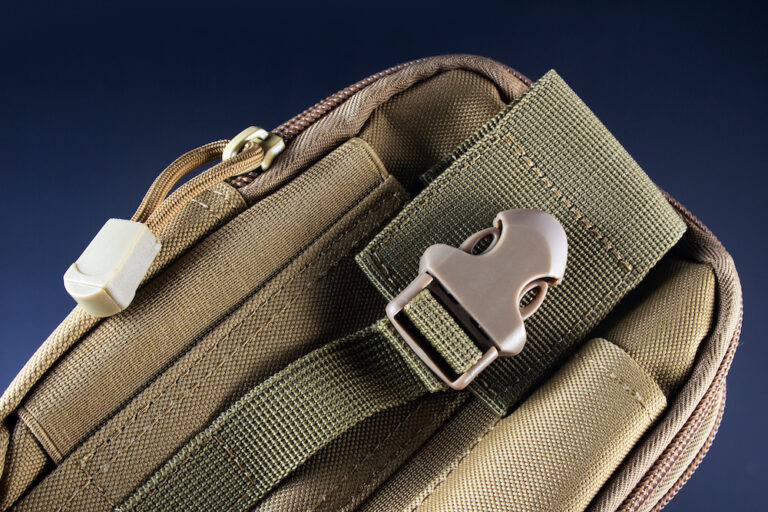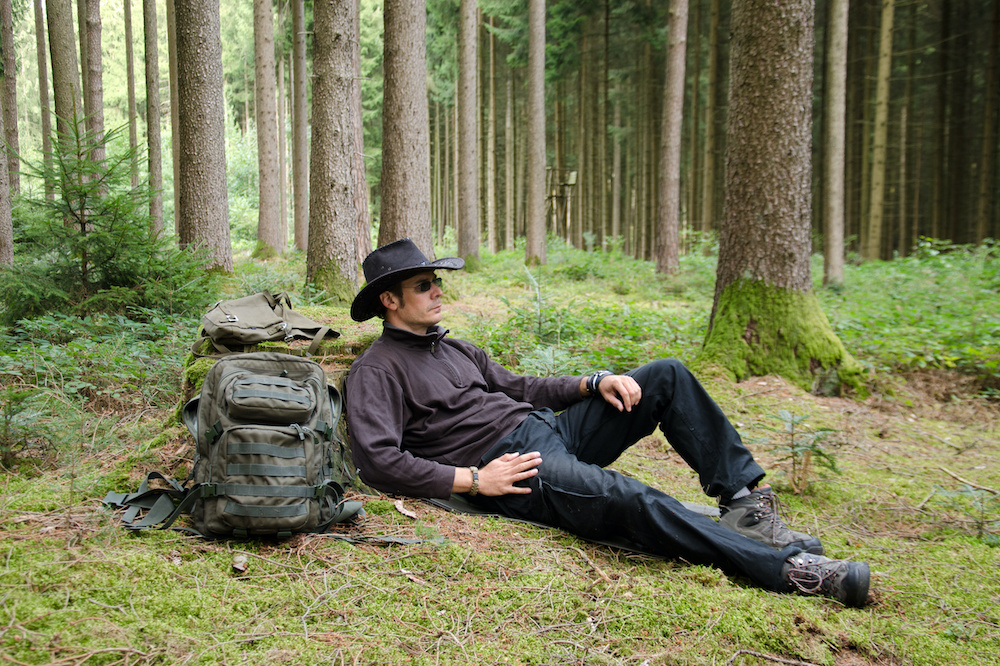Signup for our monthly newsletter and get your FREE "Tactical Gear" Guide
What Does MOLLE Stand For: A Brief Introduction
- Home
- Tactical Backpacks Advice
- What Does Molle Stand for

This site contains affiliate links to products. We may receive a commission for purchases made through these links.
If you’re the person who’s into military clothing and equipment, you’ve likely come across MOLLE gear before.
In fact, you may even own a backpack, belt, or vest with MOLLE webbing on it, but what does molle stand for?
Unless you’ve served in the military, molle isn’t a term you’ll come across very often, but stick with us as we explain all.
We’ll tell you what the acronym molle stands for and explain how to use the molle system properly to ensure your gear is attached correctly.
Table of Contents
- What Is MOLLE?
- Who Invented MOLLE?
- What Are the Essential Parts of a MOLLE?
- What Are the Different Types of MOLLEs?
How Do You Use a Molle Backpack?
How To Choose an All-Purpose Lightweight Individual Carrying Equipment
What Does MOLLE Stand For?
While MOLLE might sound like the girl next door, pronounced the same way as the name Molly, its meaning is far from anything cute.
MOLLE actually stands for Modular Lightweight Load-Carrying Equipment, but let’s take a closer look by answering “What is Molle?”, and “How do molle systems work?”
What Is MOLLE?
MOLLE is used to describe the type of equipment and backpacks currently used by many NATO armed forces personnel, including the US and British Army.
It’s also used by law enforcement, firefighters, emergency workers and is becoming increasingly popular with outdoor enthusiasts.
MOLLE gear consists of multiple rows and columns of webbing, resembling a ladder, that allows you to adapt your gear to various purposes.
This webbing is the technology that MOLLE is built upon and is called PALS.
PALS stands for Pouch Attachment Ladder System. Although it describes the webbing, the terms MOLLE and PALS are often used interchangeably.
So, if you didn’t know the difference between your MOLLE and your PLAS, then fear not, since they can both be used to describe the same gear.
It can often be found on military-style backpacks, rucksacks, vests, and belts.
Its main purpose is for you to be able to attach a variety of carrying modules, pouches, holsters, and sheaths, as needed.
It makes your gear totally customizable. Meaning that when you’re out and about, you’ll always have exactly what you need on hand.
Whether it be your first aid kit, knife, water bottle, or diaper (yes, you can even buy MOLLE mummy and daddy bags!).
Who Invented MOLLE?
Let’s take a moment to give credit to the inventors of this fantastic load-bearing system before moving on to how they work.
Credit for the MOLLE system’s invention goes to Natick Labs Research and Development, which is a division of the US Army.
They introduced the system back in 1997, but it didn’t reach widespread use until the 9/11 attacks.
The US troops started using it while serving in Afghanistan.
What Are the Essential Parts of a MOLLE?
Providing extra storage space for your hiking backpacks, tactical backpacks, and other outdoor backpacks with PALS webbing, MOLLE pouches or attachments have three main parts.
First, the compartment that will house a multitude of items, such as multi-tools, handgun magazines, and knives.
The standard size is similar to that of a regular pistol magazine.
The second part is the flap, which encloses the compartment and secures the item inside.
Lastly, the enclosure, which can be either Velcro or clips.
What Are the Different Types of MOLLEs?
There are two types of MOLLE, differentiated based on how they’re made: classic stitched and Laser Cut.
Aptly named, the classic “Modular, Lightweight Load-Carrying Equipment” was the first one to be invented and used.
It’s durable, easy to clean, and can carry a heavy load.
On the other hand, the laser cut MOLLE is more modern, having a thinner profile and lighter weight.
Plus, it doesn’t have stitching.
However, this attachment is more challenging and time-consuming to clean, especially since it easily gets dirty.
Additionally, the material slits tend to become bigger after a few uses.

How Do MOLLE Systems Work?
The PALS or webbing that runs over the surface of your backpack is designed to be interwoven with straps on a variety of attachments and then clipped or velcroed in place.
The heavy-duty webbing is usually made of extremely durable nylon.
Thus, you can rely on it to safely hold your gear in place, no matter how adventurous your day is.
The full customization offered by MOLLE is why it’s renowned for practicality and functionality.
It’s also a sought after style for fans of military-style gear.
How Do You Use a Molle Backpack?
To make a MOLLE system work for you, you need to decide what items you want to carry in your backpack and with you when you’re out and about.
If you can fit everything you need for your trip inside your backpack, then you may not need any attachments at all.
Or you may just want to limit your attachments to exactly what you need, for example, just a sheath for your knife.
On another day, you might need to carry a lot more equipment.
Having a MOLLE backpack allows you to add lots of extra gear without buying a bigger bag.
Once you’ve worked out which items you want to be the most accessible, then you can buy the appropriate attachments to secure them where you want them.
The more PLAS webbing you have on your MOLLE backpack, the more choice you have when it comes to placement.
While the way on How to use MOLLE systems is straightforward to use, it’s also effortless to use improperly.
The Wrong Way
Let’s say you buy a pouch attachment with straps that latch onto two rungs of the webbing ladder.
Many people wrongly assume that you simply thread the straps through the backpacks webbing or the two rungs. Then clip it back to itself at the bottom, or Velcro it.
While this will make the attachment stay in place, it’s not as secure as it could be by interweaving the straps.
Try simulating what would happen if the attachment were to get caught between two rocks.
If you give it a strong tug, the attachment will probably break away from the backpack.
The last thing you want is to lose your essential gear while you’re out in the field.
As such, it’s important to learn how to attach MOLLE gear properly.
The Right Procedure
If you take a closer look at your attachment, you’ll notice that it too has MOLLE webbing on it.
Here’s what you need to do:
- First, you want to feed the straps through the first rung of the ladder on your backpack.
- Then feed them back through the upper rung on the attachment.
- Next, feed the straps through the second ladder rung on your backpack.
- Finally, thread it back through the lower webbing on your attachment.
After clipping or Velcro-ing your attachment into place this time, you’ll immediately notice the difference in sturdiness between these two methods.
The only way to remove the attachment, once secured correctly, is to undo the fastener and unthread the straps physically.
How To Choose an All-Purpose Lightweight Individual Carrying Equipment
As one of the most versatile and beneficial items for your backpacks and tactical vests, you’ll already find a lot of MOLLE brands and models.
Hence, below are some of the essential factors that you need to consider when choosing and purchasing these utility pouches.
Size
MOLLEs are available in several sizes, so you need to look into the survival, essential, and mission gear items you would usually bring with you.
It’s also best to have different sizes of extra pouches on hand to ensure you have something to use just in case you have a new item to carry on your next trip.
Durability
Like any other product, especially for outdoor use, it’s important to consider the MOLLE-ready pouches’ durability.
One way to determine this is the material used in their construction, and nylon is on top of the list, followed by polyurethane or neoprene.
Color
Some might think that the color of the MOLLE load-bearing equipment is just for aesthetics, but the color plays a critical role.
Supposed you’re hunting or doing your job as a member of the Armed Forces, Military Forces, or Police Forces.
In this case, it’s best to have a piece of gear that has a neutral color or that can blend well with the surrounding for camouflage for your safety.
Some also choose MOLLE-ready pouches with a color similar to their backpacks for uniformity.
Price
It’s always easy to purchase something that won’t put a hole in our pockets, but these general-purpose gear pouches will ensure your survival while you’re out and about.
After all, they carry crucial items that you would need in case of an emergency, when you get lost, and more.
Therefore, it’s best to consider products made by some of the well-known outdoor equipment and military equipment brands, which usually come at a higher price tag.
That said, they will surely meet one of the most important factors we mentioned, durability, so they’re long-lasting investments.
Still, we’re not saying that just because the modular pouch attachment is affordable, it isn’t high quality.
If you’re on a tight budget, just make sure you read reviews and testimonials before making a final purchase from an unknown brand or choosing items with a very low price tag.
The Beneficial MOLLE System
Now you know what does MOLLE stand for and how to use MOLLE systems to secure your gear.
Once you start using the MOLLE system, you’ll never look back.
The great thing is that all of the MOLLE accessories are compatible with all your MOLLE gear.
Owning a MOLLE backpack will allow you to customize it for each new adventure, helping all of your gear work harder for you.
